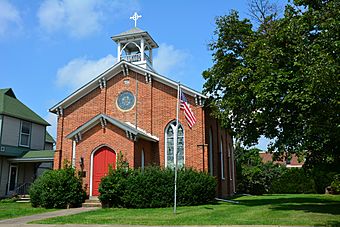St. Peter's Episcopal Church and Rectory facts for kids
Quick facts for kids |
|
|
St. Peter's Episcopal Church and Rectory
|
|

Front of the church
|
|
| Location | 36–38 W. Campbell St., Blairsville, Pennsylvania |
|---|---|
| Area | 0.4 acres (0.16 ha) |
| Built | 1830, 1889 |
| Architect | Robert Gregory |
| Architectural style | Eastlake, Gothic Revival, Early Gothic Revival |
| NRHP reference No. | 88000463 |
| Added to NRHP | May 9, 1988 |
St. Peter's Episcopal Church and Rectory is a very old and important church building and its nearby house, called a rectory. They are located in Blairsville, Pennsylvania, which is in Indiana County, Pennsylvania.
What is St. Peter's Church?
St. Peter's is an Episcopal church. This means it belongs to a Christian group called the Episcopal Church. The word "rectory" refers to the house where the church's priest or minister lives.
The Church Building
The church building itself was finished in 1830. It is a small, rectangular building made of brick, sitting on a strong stone foundation. Its design is in an Early Gothic Revival style. This style was popular a long time ago and often includes pointed arches and tall windows, like old European cathedrals. The church has a special tower for bells, called a belfry, right above the front entrance.
The Rectory Building
The rectory, or priest's house, was built later, in 1889. It is a two-and-a-half-story house made of wood. The rectory shows parts of the Eastlake movement style. This style was known for its detailed woodwork, often with carved or turned shapes, and decorative patterns.
A Historic Landmark
Both St. Peter's Episcopal Church and its rectory are considered very important because of their history and architecture. Because of this, they were added to the National Register of Historic Places in 1988. This list includes buildings, sites, and objects that are important to American history and culture. Being on this list helps protect them for future generations to enjoy and learn from.



